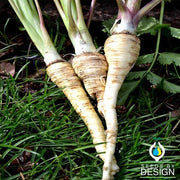DESCRIPTION
Growing Harris Model Parsnip Vegetable Garden Seeds
Seeds Per Package:
- 3 g - Approximately 280 Seeds
- 1 oz - Approximately 8,000 Seeds
- 4 oz - Approximately 32,000 Seeds
- 1 lb - Approximately 128,000 Seeds
- 5 lb - Approximately 640,000 Seeds
- 25 lb - Approximately 3,200,000 Seeds
How to Grow Harris Model Parsnip from Seed
Parsnip is a cool weather crop able to be sown directly 3 weeks before final spring frost or 3-4 weeks before first autumn frost for an early spring harvest. Like many root vegetables, parsnip does not transplant well and should always be sown direct. Plant 2-3 seeds ½" deep and 1-2" apart in very loose, well-tilled, and well-drained soil with a pH of 6.0-7.0. Seeds germinate in 10-28 days, thinning out strongest starts to 6-9" apart in the garden. Parsnips grow best with some drought, becoming wider and longer in search of moisture.
How to Harvest Harris Model Parsnip
Most varieties of parsnip may be harvested about 100 days after sowing but, for sweetest flavor, allow parsnip to experience a frost or two before harvesting. Parsnips are ready to harvest once their foliage has died back, dried, and bowed over. Like carrots, parsnip can be safely removed from the ground with a gardening fork. If sowing in the fall for a spring harvest, cover parsnip seeds with a top layer of mulch and harvest crop once the ground thaws.
About Harris Model Parsnip Seeds
- Parsnips have 36mg Calcium and 71 mg phosphorous per 100gm.
- The vitamin C level though is 17mg per 100gm which is almost 3 times the level of vitamin C in carrots.
- Parsnips can be substituted for carrots in many recipes.
- You can remove the skin and mash them like potatoes with a little butter.
- Some folks grate them into salads fresh, while others add them to stews and soups.
- There are many ways to enjoy these tasty roots.
Did you know that Parsnips over winter with no protection in most places and are even more tasty after a freeze! Leave them right where they are until you need them. Parsnips can be stored this way as long as the soil is not water logged. You may also store them in the root cellar. Parsnips have been used form generations because they store so well and make excellent human/animal food. Parsnips make an excellent rabbit food as well as being tasty for ruminants.
Check out this article about the evolution of corn.
ATTRIBUTES
Basic Info
| Color: |
Creamy white taproot with the same white colored meat in the middle |
Growing Info
| Taxonomy: Pastinaca sativa
: |
|
| Days to Maturity: |
100-120 days |
| Days to Germination: |
10-28 |
| Hardiness Zone: |
Annual 3-10 |
| Planting Depth: |
½ |
| Plant Spacing: |
6-9 Inches |
| Plant Height: |
18-24 Inches |
| Row Spacing: |
12-18 Inches |
| Growth Habit: |
Leafy taproot |
| Soil Preference: |
Loose, Organic, composted, well-drained |
| Temp Preference: |
Cooler, 45-75 °F |
| Light Preference: |
Full sun - partial shade |
Other
| Diseases/Pests: |
Few known pests and diseases. Watch for carrot rust fly known to infect plants with parsnip root canker. |






